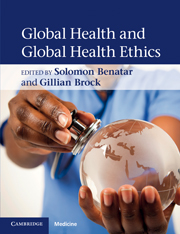Book contents
- Frontmatter
- Contents
- List of contributors
- Introduction
- Section 1 Global health, definitions and descriptions
- Section 2 Global health ethics, responsibilities and justice: some central issues
- Section 3 Analyzing some reasons for poor health
- Section 4 Shaping the future
- 20 The Health Impact Fund: how to make new medicines accessible to all
- 21 Biotechnology and global health
- 22 Food security and global health
- 23 International taxation
- 24 Global health research: changing the agenda
- 25 Justice and research in developing countries
- 26 Values in global health governance
- 27 Poverty, distance and two dimensions of ethics
- 28 Teaching global health ethics
- 29 Towards a new common sense: the need for new paradigms of global health
- Index
- References
28 - Teaching global health ethics
Published online by Cambridge University Press: 01 March 2011
- Frontmatter
- Contents
- List of contributors
- Introduction
- Section 1 Global health, definitions and descriptions
- Section 2 Global health ethics, responsibilities and justice: some central issues
- Section 3 Analyzing some reasons for poor health
- Section 4 Shaping the future
- 20 The Health Impact Fund: how to make new medicines accessible to all
- 21 Biotechnology and global health
- 22 Food security and global health
- 23 International taxation
- 24 Global health research: changing the agenda
- 25 Justice and research in developing countries
- 26 Values in global health governance
- 27 Poverty, distance and two dimensions of ethics
- 28 Teaching global health ethics
- 29 Towards a new common sense: the need for new paradigms of global health
- Index
- References
Summary
In Japan, Switzerland and Australia, the average life expectancy is about 82 years. But in Sierra Leone, Angola and Afghanistan, it is about 41 years. Within the USA, people in some social groups can expect to live 20 years longer than people in other social groups. What are we to make of a world with such unequal health prospects? What does justice demand in terms of global health? And what is our moral responsibility?
I have thought about those questions for many years. In fact, I have fallen into a pattern that is both commendable and deplorable. I grow concerned about global health, study the causes of poor population health, think about the moral implications, and take some action. Then, gradually, I slip back into my daily concerns and work. These concerns and work are not without merit, but they don't provide much space for activities that promote global health and justice.
But over the last 15 years, I have done at least one thing consistently: I have integrated ethical issues about global health into my teaching. In courses for medical students, I have tried to address fundamental issues about global health, justice and responsibility. And I have done the same in courses attended by students from other fields – nursing, biology, engineering, philosophy and drama. I have also reached out beyond the university to discuss global health ethics with high school students, religious groups, professional associations and the general public.
- Type
- Chapter
- Information
- Global Health and Global Health Ethics , pp. 319 - 328Publisher: Cambridge University PressPrint publication year: 2011
References
- 5
- Cited by

